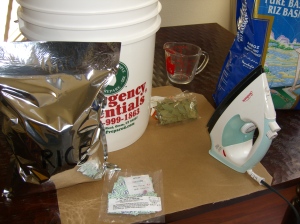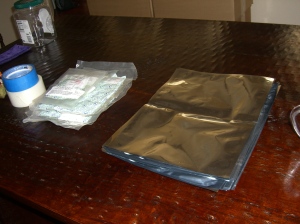Living in an apartment in the middle of a big city, there is always a chance a situation will arise that will require us to bug out in a hurry. We need to be able to bug out of our home at a moment’s notice, just in case we ever need to leave. I will address what situation might cause us to leave in another post; for now, I am just focusing on the bug out bag.
I have read enough survival and emergency websites to know you would need some basic items in your bug out bag to last you until you reach your destination. Being new at this, I started reading up on all the essentials and found it can be quite overwhelming.
Depending on the situation,bugging out may entail a lot of walking, carrying the pack and maybe camping out. I have limited camping experience, and have never gone backpacking in my life.
To get more information about what to pack, my husband and I decided to check out a class called Backpacking 101, offered for free at our local REI store. Surprisingly, the class was packed full of families, couples and Boy Scout troops. We figured an experienced backpacker would be knowledgeable about the best items to consider bringing with you. If you are an experienced backpacker then you likely will know all this, but what I learned was all good information for a beginner like me. Naturally the real purpose of our attending the class was to learn tips that we can apply to packing our bug out bag.
When considering the contents of your bug out bag, you will need to consider the five survival necessities as follows:
- Food
- Water
- Fire
- Shelter
- Security
Once these basic needs are covered, you will also want additional items to stay comfortable in a difficult situation.
Backpack
The backpack should be of good quality, sturdy and as lightweight as possible. It should also fit comfortably to your size and body type. A good backpack will have a hip belt so most of weight sits on your hip and not your shoulders. It should have also have enough space, and reasonably priced. To avoid back strain, a rule of thumb is, a person should carry a pack weighing no more than 30% of his or her weight.
Security Guy has a good article about choosing your bug out bag, aptly titled “Bug Out Bag” at http://www.securitywhip.com/
Clothes
Depending on the weather, you would want to dress appropriately and in layers if possible. You may start out walking in the cool morning air, but will eventually get hot as the day progresses. You will want to remove layers as you go.
Wool socks or synthetic fiber socks are better than cotton, as cotton retains moisture and will take a long time to dry if you sweat or get wet.
Synthetic fibers like fleece are good, as they draw moisture away from the skin.
Shoes
Hiking shoes are the best kind of shoes for walking long distances, and you will want to “break them in” before you have to bug out.
It is a good idea to carry moleskin pads which are self sticking cotton flannel pads to place over sensitive areas before blisters can develop.
I now understand you must take care of your feet, as they could potentially be your only transportation.
Map and compass
Even if you have a GPS device, it is a good idea to keep a map and compass as backup, as there are certain areas where a GPS will not work well, such as valleys, or in bad weather.
First Aid
Personalize your first aid kit according to your needs. I personally would want pain reliever, acid and diarrhea medicine, antibiotic cream for burns and insect bites, allergy medicine, wound care materials, etc. I could write a whole separate article just on first aid supplies, so I will save this for another entry.
Tent
You would want the tent to be as lightweight as possible. If it is too bulky or heavy for one person, you can split and pieces among your group to spread out the weight, as long as you stay together. You would want a ground sheet inside your tent to keep water away from you.
Sleeping Bag
The sleeping bag should be lightweight and versatile for various types of weather, and go down to around 20 degrees if possible. Down is good and comfortable, but it must not get wet; while synthetic fill bags are not as comfy, but will dry well if the sleeping bag gets wet.
Water Purifier
There are many water bottles that will purify water; I also wrote a previous article https://apartmentprepper.wordpress.com/2010/06/07/insuring-against-3-days-without-water/ on water purification techniques. I may also considering getting a Steri-pen which can purify with UV light, but you would still need to filter out pebbles and impurities with a cloth or bandanna before using.
Food
Dehydrated or freeze-dried food is highly recommended; as all you need to do is add hot water to the pack and you are done. I bought a few samples for the family to try out, and I will publish our review at another post.
Cooking and Eating Utensils
The lighter the better, since you have to carry these things as well. I will need to investigate the aluminum and titanium choices.
Stove and Firestarting materials
A means of cooking your food and boiling water are necessities. We have multiple ways to start a fire and keep it going and I plan to experiment on various methods as soon as I gather up the materials. We saw the Jet Boil canister which runs on butane, which looked very light and compact, but for now, we have our propane camp stove, which does weigh a lot more, but will do in an emergency.
Toilet Paper
The Charmin camping toilet paper would be nice and compact, but in an emergency, there are other choices. I covered this subject in another article: Not for the Squeamish: Toilet Paper Substitutes https://apartmentprepper.wordpress.com/?s=Toilet+paper
Weapons
You will need to be able to protect yourself in a bug out situation. Guns, crossbows, slingshot, pepper spray–there is a variety of options and will vary according to your personal choice.
Documents
We recently assembled our grab and go binder, containing important personal documents, as described in this article https://apartmentprepper.wordpress.com/2010/07/06/the-grab-and-go-binder/.
Pocketknife and Other Tools
We already carry a pocketknife in the car, but need one for the bug out bag. Other good tools include camp shovel, ax, saw, pick, machete, etc. There is so much detail and choices, whole posts can be written on each one. Since we are covering the basics, I won’t go into much detail.
Communication
Depending on the emergency situation, your cell phone/ solar charger, crank radio will help you stay connected.
Other useful items that will make life bearable:
- Sunglasses, sunscreen, and wide-brimmed hat are all useful sun protection.
- Multi-towel – this is a nifty little towel that takes the place of several bath towels and will dry quickly. It is not absolutely necessary but nice to have if the budget allows.
- Headlamp – Easier than a flashlight, as you can keep your hands free to do other chores while in the dark.
- Insect repellant – this is a must have here in Texas, with all the large bugs and mosquitoes. The brands with the most Deet are very effective, but must be used sparingly, as they are also corrosive and may be harmful. There are also natural alternatives such as lemon-eucalyptus herbal formulas, but may not be as effective as Deet.
- Soap, toothbrush, and other toiletries such as deodorant are not life saving, but advisable for personal hygiene and morale.
- Rain gear such as jackets and ponchos; backpack cover since most backpacks are not waterproof
- Rope
- Plastic bags
- Deck of cards for entertainment
I know this list does not cover absolutely everything needed to bug out; this is only a basic starter list. I also did not include individual situation items such as baby items if there is a baby in the family, pet items if you have pets with you, etc. A concern that occurred to me as I was making this list is, this could get expensive and we don’t have all the funds to buy all this stuff. But I realize you have to start somewhere and we can assemble these items slowly as we have the funds. I will also check close-out sales and scour garage sales or Craigslist for used quality items. Building a bug out bag is very personal and the contents will vary greatly according to each person’s needs. As apartment preppers, we would have to balance needs versus space and budget constraints while making our choices.
Read Full Post »
 The next day, you will notice the bags look shrunken. This is the oxygen absorber doing its job.
The next day, you will notice the bags look shrunken. This is the oxygen absorber doing its job.





